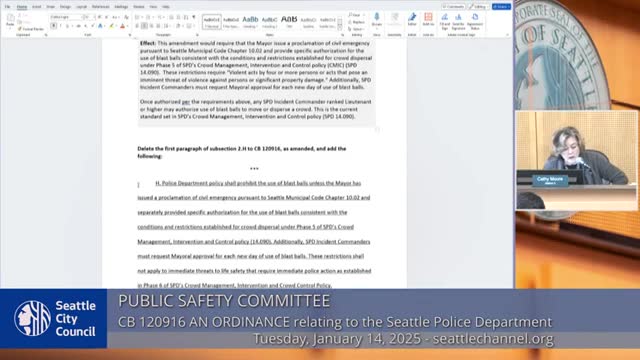Seattle Council debates SPD's use of blast balls amid concerns over public safety risks
January 18, 2025 | Seattle, King County, Washington
This article was created by AI summarizing key points discussed. AI makes mistakes, so for full details and context, please refer to the video of the full meeting. Please report any errors so we can fix them. Report an error »

In a recent Seattle City Council Public Safety Committee meeting, a heated discussion unfolded regarding the use of blast balls by the Seattle Police Department (SPD) during crowd control situations. The meeting, held on December 10, 2024, highlighted concerns over the potential risks associated with these less-lethal devices, particularly in light of past incidents where their deployment led to unintended injuries.
One council member emphasized that an amendment proposed would allow SPD to use blast balls without requiring a declaration of civil emergency or direct authorization from the mayor. This change was framed as a necessary measure to ensure immediate action in life-threatening situations. However, the council member also acknowledged the inherent dangers of blast balls, which are designed to bounce and can inadvertently harm bystanders.
The discussion underscored a critical distinction between "less lethal" and "non-lethal" weapons, with council members stressing that no weapon is entirely without risk. The council member pointed to historical data from 2015 and 2020, illustrating that blast balls have caused injuries in past protests, raising questions about their safety and effectiveness in managing crowds.
Concerns were also raised about the broader implications of allowing unrestricted use of such devices. The council member argued that the mayor should have the ultimate authority to approve their use, ensuring that the decision to deploy potentially harmful tools is made with careful consideration of public safety. This sentiment echoed the recommendations from the Washington Attorney General, which advised against using noise flash diversionary devices, like blast balls, for crowd management except as a last resort.
As Seattle prepares for future demonstrations, the debate over the use of blast balls and other less-lethal weapons continues to be a focal point for city leaders, reflecting a growing awareness of the need for accountability and safety in policing practices. The outcome of these discussions may shape the future of crowd management strategies in the city, as officials seek to balance public safety with the rights of citizens to protest peacefully.
One council member emphasized that an amendment proposed would allow SPD to use blast balls without requiring a declaration of civil emergency or direct authorization from the mayor. This change was framed as a necessary measure to ensure immediate action in life-threatening situations. However, the council member also acknowledged the inherent dangers of blast balls, which are designed to bounce and can inadvertently harm bystanders.
The discussion underscored a critical distinction between "less lethal" and "non-lethal" weapons, with council members stressing that no weapon is entirely without risk. The council member pointed to historical data from 2015 and 2020, illustrating that blast balls have caused injuries in past protests, raising questions about their safety and effectiveness in managing crowds.
Concerns were also raised about the broader implications of allowing unrestricted use of such devices. The council member argued that the mayor should have the ultimate authority to approve their use, ensuring that the decision to deploy potentially harmful tools is made with careful consideration of public safety. This sentiment echoed the recommendations from the Washington Attorney General, which advised against using noise flash diversionary devices, like blast balls, for crowd management except as a last resort.
As Seattle prepares for future demonstrations, the debate over the use of blast balls and other less-lethal weapons continues to be a focal point for city leaders, reflecting a growing awareness of the need for accountability and safety in policing practices. The outcome of these discussions may shape the future of crowd management strategies in the city, as officials seek to balance public safety with the rights of citizens to protest peacefully.
View full meeting
This article is based on a recent meeting—watch the full video and explore the complete transcript for deeper insights into the discussion.
View full meeting
